 |
| photo: Sofie Pedersen source |
Design in Context is a:
"comprehensive initiative for the exchange of expertise and experience between Danish and Palestinian designers. The objective is to rethink Palestinian textile design and equip the local women so that they are able to develop products with a wider market appeal. The plan is for the Danish designers to visit Palestine up to four times each year to participate in workshops with local designers and handicraft workers"The Fashion and Textile Institute (FTI):
"is the first educational institution in Palestine for textile and fashion design. The institute was founded in 1994 and offers a two-year education in fashion design. The FTI is located in Beit Sahour, on the outskirts of Bethlehem."Designskolen is:
"an education and research institution at The Royal Danish Academy of Fine Arts (KADK). The institute is based in Copenhagen, Denmark, and has existed for 135 years."All these things come together in Sofie Pedersen's interesting post / article in WomenDesign. This begins:
 |
| photo: Sofie Pedersen source |
Women’s lives told through the medium of embroidery
Author: Text and photo: Sofie Pedersen. Published: 03-12-2012
Personal stories are woven into Palestinian embroidery – stories that both challenge and surprise young Danish women. Expertise and information sharing were the buzzwords when students from The Royal Danish Academy of Fine Arts School of design (Designskolen) and students from the Palestinian Fashion and Textile Institute first met with women from various handicraft cooperatives in Palestine.
“That cross-stitching is brimming with sex; all of the embroidery with red thread refers to menstruation. The local embroidery expert and designer Omar-Joseph Nasser-Khoury says shell-shaped patterns symbolise the woman’s vagina. Or ‘the woman’s reproductive organ’, as he puts when he’s within earshot of the Palestinian ladies,” explains a clearly impressed Maria Albertsen, project associate and designer from Designskolen in Denmark.
In partnership with the Palestinian designer Omar-Joseph Nasser-Khoury, she is responsible for the creative content of a series of workshops aimed at building bridges between Danish and Palestinian design, the goal of which is to provide mutual inspiration.
"The women of Palestine have a long and proud tradition of embroidery, but the work is time consuming and the pay is poor. Because of this, the challenge for the Danish designers has been to collaborate with their Palestinian colleagues and fellow artists in order to make embroidery relevant in a wider context with greater appeal, consequently giving the Palestinian women improved opportunities of earning money.
"The exchange of ideas is being facilitated through the Danish NGO Det Danske Hus i Palæstina [The Danish House in Palestine]. The cornerstone of the project, which is called Design in Context, is professional dialogue and exchange of experience and knowledge between Danes and Palestinians. In addition to project associate Maria Albertsen, two students from Designskolen in Denmark are also participating – Tine Winther Rysgaard and Josefine Gilbert.
"From Palestine, 12 students from the Fashion and Textile Institute at Beit Sahour are participating, along with 12 women from various handicraft cooperatives, organised under the Dalia Association. This is a Palestinian NGO that focuses on two key areas: “women supporting women” and “The Village Decides”, both of which focus on civil society and capacity accumulation.
"In the first workshop with the Palestinian women and the Danish designers, the group is given a detailed introduction to the symbolism of the embroideries embellishing the traditional Palestinian women’s dress. It is particularly surprising to the Danes how many stories are told through the cross-stitching on this traditional, loose-fitting garment that covers the entire body from the neck down to the ankles. These embroideries refer to genitalia, the woman’s menstrual cycle and encourage potential courters (translation: Andrew Bell)You can read the rest here. This is a really great project. Kudos to all involved. We look forward to learning more.
Now, for our education officers, here's your assignment:
Imagine that you, as an education officer of the Archive, have been asked to organize a similar series of workshops to promote "professional dialogue and exchange of experience and knowledge" between Palestinians and and textile designers from your current country of residence:
- What cross cultural connections in your own environment / community might be brought together?
- What will you call your project?
- Tell us what kind of budget your workshops requires. Then imagine you only receive half. What cuts are required? How would you work around them? Who else could you approach for funding?
- How would you select your Palestinian participants?
- How would you structure your workshops? What topics would be covered in each? Who would participate?
- After attending the first workshop Sofie Pedersen states in her article that "the Danes" attending the workshop now understand "traditional ... embroideries refer to genitalia, the woman’s menstrual cycle and encourage potential courters". Is this singular conclusion one you would want your own non Palestinian workshop attendees to reach? If not, explain in detail what conclusions you would prefer, and what components of pre1948 Palestinian costume and embroidery you'd hope attendees would take on board.
- Create a reading list on Palestinian costume for both your Palestinian and non Palestinian attendees. Make sure you feature publications in languages familiar to your workshop attendees.
- Danish student Tine Winter Rysgaard is quoted right at the end of the article "there’s still no doubting the fact that the Palestinian aesthetic is very different than ours". A similar situation may arise in your workshops. How would you try to redress aesthetic differences? More importantly, how would you define "the Palestinian aesthetic"?
- The use of the sketchbook mentioned in the second part of the article proved a resourceful practical tool for both groups attending the workshops. What practical tools might you include?
Send your responses to us via the staff email account. We look forward to hearing what you all come up with :)




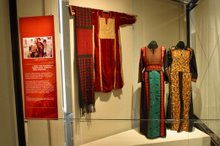






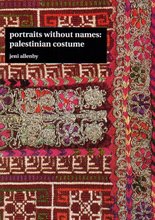
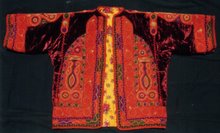
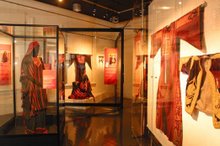
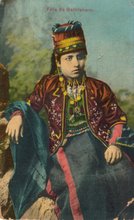

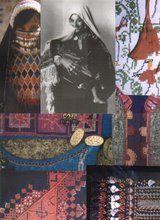













No comments:
Post a Comment